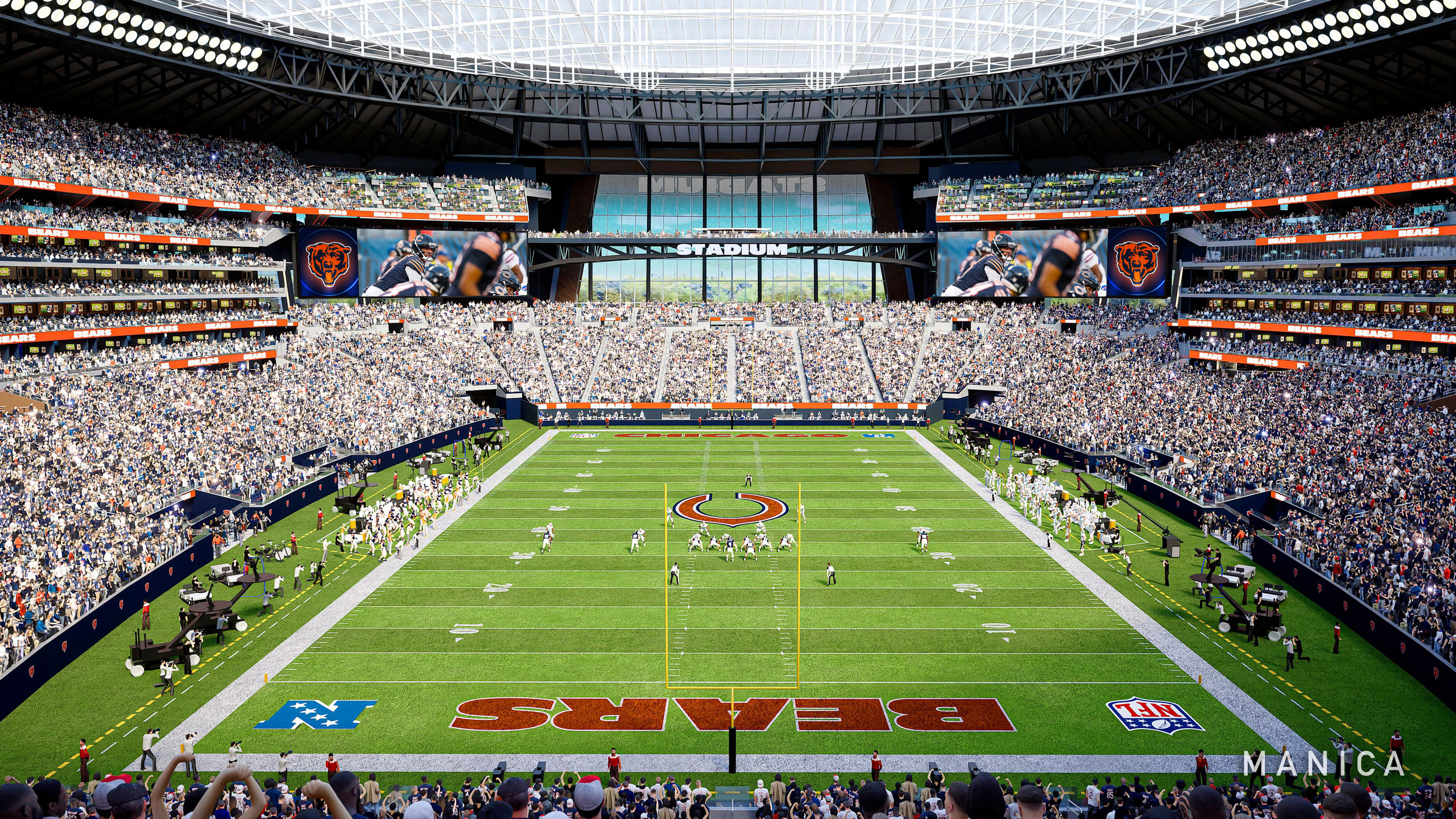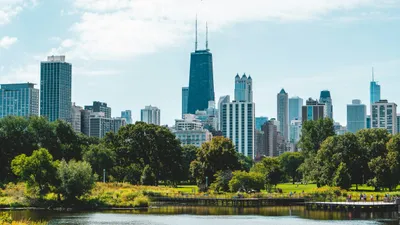Since 1971, Soldier Field has been the Chicago Bears’ hallowed home, where legends like Walter Payton and Mike Ditka made history as fans braved lakefront winds. But nostalgia alone can’t keep up with the NFL’s future. Today’s league demands more than old-school charm to attract talent, impress fans, and secure sponsors.
Despite its storied past, Soldier Field lacks the modern comforts and spectacle football now requires—cramped concourses, lackluster amenities, and parking woes make attending games a challenge.
For years, the Bears weighed options: should they dome Soldier Field, renovate it, or build anew by the lake? Each idea fizzled into wishful thinking.
Now, change is real. The Bears are eyeing a 326-acre site at 2200 Euclid Avenue in Arlington Heights—once Arlington International Racecourse—to completely reimagine football Sundays.
The Chicago Bears Arlington Heights project is a $5 billion vision: a sleek enclosed stadium with an entertainment district featuring hotels, apartments, shops, restaurants, and vast office space. It’s about more than football—it’s an all-day destination where tailgating meets luxury living and game days mean rooftop bars instead of parking struggles.
If realized, watching the Bears could become a transformative experience—from touchdowns to post-game adventures—all in one dynamic neighborhood.
Project Overview
Let’s take a walk through the future home of the Chicago Bears—a place where echoes of thundering hooves give way to roaring crowds, and what once was the Arlington International Racecourse becomes the heartbeat of a new era. Picture it: 2200 Euclid Avenue, where dreams of Super Bowl Sundays and everyday adventures are about to collide.
Design and Architecture
The masterminds at Manica Architecture—yes, the same folks whose blueprints have redefined stadium skylines from coast to coast—are teaming up with Hart Howerton Architects for this ambitious project. Their vision isn’t just about building a stadium; it’s about reimagining 326 sprawling acres into a year-round playground, a place where every corner buzzes with possibility.
Stadium Features
Anchoring it all is the Bears’ brand-new lair: an enclosed stadium that laughs in the face of Chicago’s moody weather. No more shivering through fourth quarters or praying that your poncho holds. Here’s what’s on deck:
- Seating for 60,000, expandable to 70,000 when Beyoncé or the Big Game comes to town
- A fixed roof overhead, making rain delays and wind chills a distant memory
- State-of-the-art amenities designed to spoil fans rotten
This isn’t Soldier Field 2.0—it’s a bold leap forward, ready to host everything from playoff runs to epic concerts, no matter if Lake Michigan decides to throw a tantrum.
Community Development
But let’s zoom out. The Bears aren’t just plopping down a football palace; they’re orchestrating a full-blown community revival. Imagine:
- 1,150 new residences forming a buzzing neighborhood
- 400 hotel rooms for out-of-towners eager to soak up the action
- 300,000 square feet devoted to retail therapy—think mouthwatering bites, boutique finds, and late-night laughs
- 200,000 square feet of office space fueling local jobs and entrepreneurial dreams
It’s more than concrete and steel—it’s an invitation for life to unfold here every day of the year. Whether you’re clocking in for work or catching up with friends over coffee before kickoff, this district promises energy long after the final whistle.
Year-Round Destination
The magic? It doesn’t vanish when football season fades. Maybe you’re snagging tickets for showdowns with AFC heavyweights like the Dolphins or Bills—or maybe you’re just coming by for a summer festival, shopping spree, or community block party. The goal is simple: make Arlington Heights not just another suburb on the map but the place Chicagoland gathers—rain or shine, win or lose, all year long.
So next time someone asks what’s brewing at 2200 Euclid Avenue, tell them: it’s not just a stadium; it’s where tomorrow begins.
Stadium Design & Features: A New Era Beyond Soldier Field

This new Bears stadium isn’t a mere update—it’s a total reinvention. Designed by Manica Architecture, it greets you with a massive glass window framing Arlington Heights, turning each game into a postcard and making the venue a luminous landmark visible for miles.
Capacity and Flexibility
Soldier Field’s 61,500 seats made it the NFL’s smallest stadium—cozy but cramped. The new enclosed stadium starts at 60,000 seats and expands to 70,000 for major events, ensuring room for everyone. This flexibility directly addresses decades of “sold out” disappointments.
Weather Protection
No more braving Chicago’s infamous weather—the fully enclosed stadium with a fixed roof keeps fans comfortable year-round. This allows the venue to host:
- Super Bowl LXV and future championships
- College Football Playoff games
- NCAA Final Four
- International soccer
- Concerts, expos, and galas
Consistent indoor conditions benefit both players and fans, guaranteeing enjoyable experiences no matter the event or season.
Revenue Generation
The outdated suites at Soldier Field are gone; the new stadium offers luxurious, tech-filled suites and expanded standing room areas—translating to more revenue through premium amenities. These lounges provide gourmet food and up-close views, delivering the elite NFL experience today’s fans demand.
In short: this stadium isn’t just bigger—it’s smarter, more flexible, and built for the next generation of Bears fans.
Economic Impact & Job Creation: What a New Bears Stadium Really Means for Illinois
Here’s the headline: $10 billion—the estimated economic boost during construction alone. A recent economic impact study calls this one of Illinois’ most ambitious infrastructure projects in decades.
Construction Jobs: Hard Hats and Hope
Arlington Heights will buzz with activity, creating 56,500 construction job years over several years—offering stable work for tradespeople and transforming 326 acres into a sports-and-entertainment hub.
Permanent Jobs: Beyond Game Day
After construction, 9,000 permanent jobs will open across the new district—in hotels, retail, offices, and apartments—fueling community growth beyond the stadium itself.
Annual Economic Impact: Not Just Sunday Glory
The stadium is expected to inject $220 million annually into Illinois’ economy from events, with the broader development totaling $1.3 billion yearly in statewide economic activity—potentially swaying lawmakers on funding.
State Tax Revenues: The Public Payback
Projected tax revenues are set to exceed the Bears’ infrastructure funding request by over $400 million. The goal: public investment that pays for itself—a compelling argument for Arlington Heights beyond nostalgia or team loyalty.
Financial Structure & Funding Challenges: How Do You Build an Empire?
Big plans demand big budgets—this one blends private ambition with public negotiation.
Cost Breakdown: Big Dreams, Bigger Bills
The project splits into two main costs:
- Stadium Construction: A fully enclosed stadium priced at $2 billion (possibly up to $3 billion).
- Mixed-Use Development: Hotels, residences, shops, and offices add another $5 billion.
Public Funding Request: Chasing Infrastructure Dollars
The Bears seek $855 million in public funds for site infrastructure, financed via hotel tax-backed bonds managed by ISFA—using existing city revenue streams without new taxes.
Complications from Existing Debt: Soldier Field’s Shadow
Chicago still owes over $534 million on Soldier Field’s 2003 renovation, with bond payments until at least 2032 funded by a 2% hotel tax surcharge. Lawmakers insist old debts must be addressed before new assistance is approved.
Additional Funding Efforts: Sweeteners & Legislative Hurdles
The Bears also seek Arlington Heights property tax breaks via legislation to freeze assessments for major projects (think Nebraska-style incentives). Passing such bills requires three-fifths majorities in both chambers during the fall veto session—a tall political order.
The path forward won’t be easy—but if history favors underdogs with big dreams, don’t count the Bears out yet.
Ownership & Revenue Model: Arlington Heights vs. Soldier Field
For decades, the Chicago Bears have played at Soldier Field—a landmark, but one where they’re just renters. It’s like hosting Thanksgiving at your cousin’s place: you bring the party, but at the end of the night, your cousin keeps the leftovers.
The New Playbook: Full Ownership
Arlington Heights changes everything. Here, the Bears would own the stadium—every dollar from parking, popcorn, suite rentals, or stadium tours goes straight to them.
- Ten home games a year? All ticket revenue is Bears’ money.
- Eight major concerts? The Bears keep it all.
- 370 private events? Every cent goes to the team.
From premium seats to Chicago dogs (no ketchup), it’s all theirs.
Game Day and Beyond
This isn’t just about football Sundays. When fans buy Bears gear or rivalry tickets at the new stadium, all profits stay with the team—no more sharing with a landlord.
Life Under Soldier Field’s Roof
At Soldier Field, things are complicated. The Illinois Sports Facilities Authority (ISFA) owns it and pays off its renovation debt through hotel taxes—not Bears’ rent—so their finances aren’t tied to the team staying put.
Why It Matters for the Bears
Why does this matter? Because owning Arlington Heights lets the Bears reinvest profits into better facilities, community programs, and maybe even a championship caliber on-field product.
The franchise is worth $8.2 billion with $629 million in annual revenue—and wants more. Stadium ownership means building equity and unlocking new revenue streams beyond game days.
It’s not just a new stadium; it’s an empire in navy and orange, securing Chicago football for generations.
Transportation & Accessibility to Arlington Heights Stadium Site
Let’s face it—no one wants game day ruined by traffic or confusing routes. Thankfully, getting to the Chicago Bears’ new Arlington Heights home should be easy. Just hop on the Metra UP-NW line and in about 45-50 minutes, you’ll arrive at Arlington Heights station—right next to the future stadium at 2200 Euclid Avenue. No transfers, no endless shuttles; just a direct ride from downtown Chicago via Ogilvie station.
Existing Rail Infrastructure
The Metra rail system already makes commuting simple, but the Bears plan to level up transportation for NFL Sundays and big events. Picture this:
- New Metra express trains bringing fans from the city faster than ever
- More frequent trains—no long waits on cold platforms
- Coordinated schedules for smooth post-game departures (no chaos)
- Shuttles linking other transit hubs so everyone gets there easily
The goal? Make arriving and leaving as exciting as the action inside.
Importance of Transit Accessibility
Transit access isn’t just a bonus—it’s key to making Arlington Heights Chicagoland’s sports and entertainment hub. Whether it’s a Bears game, a concert series, or any event, you want an easy trip. That direct Metra connection puts this stadium in rare company.
Bottom line: The Bears know fans want convenience as much as touchdowns. If everything goes smoothly, getting to Arlington Heights might be your new favorite part of game day (after watching the Bears win).
Event Hosting Capabilities Beyond NFL Games
Picture this: a cold February night, confetti falling under stadium lights, and Chicago—long relegated to watching the Super Bowl on TV—finally hosting it. That’s the vision for Arlington Heights. More than an upgrade, it’s a revolution: a sleek, enclosed stadium that opens Chicago to events Soldier Field can’t handle. No more being ruled out for Super Bowls due to winter weather; now, with a roof and modern amenities, Super Bowl LXV could land in the Windy City.
Major Revenue Opportunities
This stadium isn’t just impressive—it’s built to attract America’s biggest events:
- College Football Playoff semi-finals: High-stakes football, full hotels, and excited fans.
- High-profile games: With 60,000–70,000 capacity, it accommodates both massive NFL crowds and intimate electric atmospheres.
It’s more than football—a magnet for marquee matchups and unforgettable moments.
Annual Event Projections
Arlington Heights will be packed year-round:
- 10 home NFL games (warm even in December)
- 8 national concerts (think Taylor Swift or Beyoncé)
- 2 college football showcases
- 2 high school championships
- 1 international soccer match (imagine Messi in Chicago!)
- 350 private events/tours (from corporate functions to weddings)
Concerts alone transform the venue into a year-round hub—rain or shine—and those eight shows are a major offseason boost.
Plus, with up to 350 private events annually—from end-zone weddings to boardroom brainstorms—the stadium earns revenue even when the Bears aren’t playing.
In short: Arlington Heights is set to become Chicagoland’s new heartbeat—a climate-controlled engine powering memories and revenue year-round. Maybe soon we’ll see the Lombardi Trophy hoisted right here—indoors, where it belongs.
Political & Legislative Landscape Surrounding the Stadium Project
The path to starting construction in Arlington Heights goes through Springfield, where the Bears face significant challenges in getting approval from lawmakers. The team needs permission for $855 million in public infrastructure funding supported by hotel taxes, but passing this requires a three-fifths majority in both the Illinois House and Senate during the fall veto session—a difficult goal in any political climate.
Support from Governor Pritzker’s Administration
Governor JB Pritzker’s administration has shown support for infrastructure funding mechanisms using hotel taxes, similar to the structure that financed Soldier Field’s 2003 renovation. This backing provides crucial momentum, yet the Bears must navigate complex negotiations with multiple stakeholders. The state has made clear it expects the team to address the $534 million outstanding debt on Soldier Field before moving forward with new funding arrangements.
Proposed Mega Development Legislation
The Bears have also proposed mega development legislation that would freeze property tax assessments for large-scale projects like their planned 326-acre complex. This proposal adds another layer to legislative negotiations, as local officials in Arlington Heights and Cook County consider the long-term financial implications of such tax arrangements.
Arlington Heights Bears?
And now here comes the million-dollar question—the one guaranteed to get every die-hard fan’s knickers in a twist: if the team isn’t actually playing in Chicago, are we talking a brand-new name? Well, straight from the horses mouth…
“We will always be the Chicago Bears.”
Currently nine NFL teams play in stadiums located outside the cities they represent including:
•Buffalo Bills (Orchard Park, NY)
•Dallas Cowboys (Arlington, TX)
•Los Angeles Chargers (Inglewood, CA)
•Los Angeles Rams (Inglewood, CA)
•Miami Dolphins (Miami Gardens, FL)
•New York Giants (East Rutherford, NJ)
•New York Jets (East Rutherford, NJ)
•San Francisco 49ers (Santa Clara, CA)
•Washington Commanders (Landover, MD)

